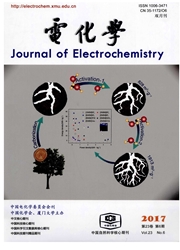

 中文摘要:
中文摘要:
应用电化学现场表面增强拉曼光谱(SERS)以及直接电化学合成技术分别研究了非水体系中苯并咪唑及2-巯基苯并咪唑在铜电极表面的吸附行为及其与三苯基膦(pph3)共存的表面过程.在较负电位区间苯并咪唑主要以分子形式吸附在电极表面.在较正电位区间,电极表面生成类高分子(CuBIM)n膜,具有缓蚀作用,对含有pph3的该体系,Cu+首先与pph3配位形成稳定的阳离子,进入溶液之后与BIM配位生成稳定的配合物,导致不能在表面有效地成膜而破坏了苯并咪唑的缓蚀作用.2-巯基苯并咪唑在Cu表面主要通过自组装单层方式在电极表面吸附,且在实验测试的电位区间内,MBI均是以S端与金属表面作用,其吸附取向随电位正移由倾斜逐渐向接近垂直过渡,并在金属表面形成MBI单分子层膜.pph3的加入不影响MBI在Cu电极表面的成膜行为.电化学现场模拟合成及产物结构组成解析为推断表面反应过程提供了直接证据.
 英文摘要:
英文摘要:
The surface adsorption of benzoimidazole (BIMH) and 2-mercaptobenzimidazole( MBI) was investigated by electrochemical in-situ surface enhanced Raman spectroscopy (SERS) and direct electrochemical synthesis on Cu electrode. The influence of the neutral ligand of triphenylphosphine (pph3) on the adsorption and surface coordination of BIMH and MBI were investigated respectively. BIMH interacted with metal surface by the neutral molecule to form chemical adlayer in the extremely negative potential,while it adsorbed onto metal surface through the N atoms to form a polymer film which may suppress the corrosion of the metal. The introduction of pph3 destroyed the film formation of BIMH on Cu electrode through the production of dissoluble cation of Cu + and pph3. MBI was adsorbed onto Cu surface by self assemble monolayer through S atom at the full potential range. The orientation underwent a transformation from tilt to vertical to electrode surface when the potential was shifted in positive direction. No influence of pph3 was placed on the adsorption behavior. The results deduced from the in-situ spectroscopic studies were in good agreement with the structural information from the complexes synthesized by electrochemical method.
 同期刊论文项目
同期刊论文项目
 同项目期刊论文
同项目期刊论文
 Probing the adsorption of methylimidazole at ionic liquids/Cu electrode interface by surface-enhance
Probing the adsorption of methylimidazole at ionic liquids/Cu electrode interface by surface-enhance Surface Treatment and Surface Enhanced Raman Spectroscopic Studies on Au/Ag Alloy Nanoparticle Assem
Surface Treatment and Surface Enhanced Raman Spectroscopic Studies on Au/Ag Alloy Nanoparticle Assem Synthesis of Magnetic Fe2O3/Au Core/Shell Nanoparticles for Bioseparation and Immunoassay Based on S
Synthesis of Magnetic Fe2O3/Au Core/Shell Nanoparticles for Bioseparation and Immunoassay Based on S Adsorption of 2-amino-5-cyanopyridine on a gold surface as probed by surface-enhanced Raman spectros
Adsorption of 2-amino-5-cyanopyridine on a gold surface as probed by surface-enhanced Raman spectros Electrodeposition of Cu Nanoparticles Layers in Ionic Liquid and Surface Enhanced Raman Spectroscopi
Electrodeposition of Cu Nanoparticles Layers in Ionic Liquid and Surface Enhanced Raman Spectroscopi 期刊信息
期刊信息
